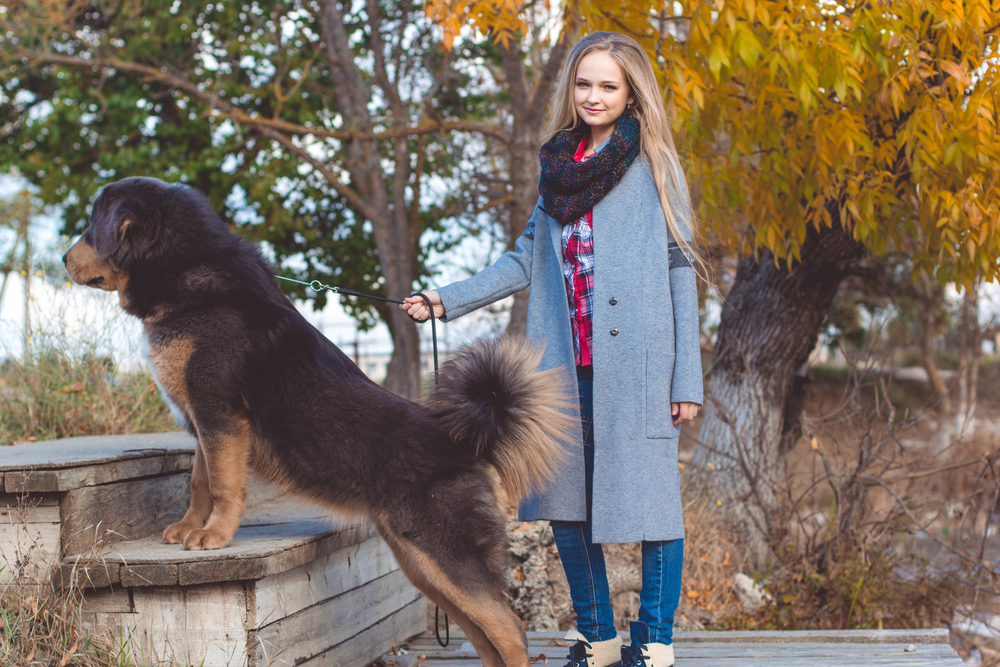From the same part of the world as Mount Everest comes something almost as large and impressive: the Tibetan Mastiff. This ancient breed is said to have protected monasteries for hundreds of years. Now, this large dog breed stands guard at front entryways across the world.


Tibetan Mastiffs may be classified as working dogs, but they’re definitely not “all work, no play” pups. Get to know these big and beautiful brutes, and you might just find your new best friend…
Breed Overview
Also Known As…
Do Khyi/Do-Kyi. TM. Hagrid, the gentle giant, “The wolf-bear that lives next door.”
What Is The History Of The Tibetan Mastiff?
As you might have guessed from the first half of the name, Tibetan Mastiffs hail from the mountainous regions in and around Tibet, such as Nepal, northern India, and southern China. Canine historians believe the Tibetan dog may have inhabited this area for at least 3,000 years.1
But what about the Mastiff part of the name? You might be thinking, “Hey, that doesn’t sound like a Tibetan word!” And you’d be right. The title of “Mastiff” was probably bestowed upon this large dog breed by Europeans, who had the massive English Mastiff as the closest comparable size reference.
Aside from the clues we can pick up from the Tibetan dog’s name, little is known about the origins of these humongous heavyweights. However, their written history begins in the mid-1800s, when a handful of Tibetan Mastiffs made their way from India to England as royal presents.1 Over the next several decades, they began to trickle in as pets for non-royal types, too.
As far as the large breed’s history in America goes, the first two TMs were apparently gifted to President Eisenhower by the Tibetan head of state in the 1950s.1 While they were likely supposed to be White House mascots, they clearly didn’t take to the confined halls of the West Wing; rumor has it the President shipped this original pair off to a farm. Starting in 1970, more and more TMs made their way to the U.S. and began multiplying, becoming a semi-rare but beloved breed today.


How Big Do Tibetan Mastiffs Get?
Height: 24–30 inches
Weight: 70–150 pounds
How Long Do Tibetan Mastiffs (Generally) Live?
Despite the usual trend of limited lifespans for larger dog breeds such as the Bernese Mountain Dog, Tibetan Mastiffs have a surprisingly long life expectancy for their size, often living between 10 and 12 years.
What Is A Tibetan Mastiff’s Temperament & Personality Like?
On the surface, Tibetan Mastiffs are stoic, serious guardians. Due to their watchdog background, they’re naturally suspicious of strangers. Ever alert, a TM is never afraid to use that big, booming voice to tell unfamiliar faces to back off.
However, that’s where their guard dog nature ends. Tibetan Mastiffs are all about defense—not offense. Sure, they’ll tell intruders to go away, but they won’t chase after them. As soon as the delivery driver steps off the porch, it’s back to dozing on the lounge chair.
If you’re lucky enough to grow close to a Tibetan Mastiff puppy, you’ll see a completely different side of the breed. TMs are protective because they care about you and your family, not because they have three thousand years of pent-up aggression. They can be very affectionate with trusted friends, so prepare yourself for a well-meaning avalanche of fur and doggy drool.
Are Tibetan Mastiffs Good With Kids? Cats? Dogs?
Critters and kiddos of all ages may initially be put off by the sheer size of this large breed. And the hesitation goes both ways—TMs like to suss out the situation before they let anyone in.
Ultimately, as long as a child is respectful toward a towering Tibetan Mastiff—that means no tail tugging, ear yanking, or paw pad poking—the two should have no trouble getting along
As for cats and other dogs, altercations are rarely an issue. Remember, TMs don’t want to fight—they just want to be left alone. Because they’re not hunters by trade, Tibetan Mastiffs rarely see cats and small dogs as prey. They might let out a quick warning, but they probably won’t make a big deal of it.
If you’re considering adopting a Tibetan Mastiff and aren’t sure how they’ll interact with your youngins, here’s the biggest takeaway: introduce your Tibetan Mastiff puppy to as many other creatures and kids as you can, as soon as possible, and always be there to supervise. Early socialization helps TMs become accustomed to people and animals outside your family. Being an experienced dog owner helps as well.


Do Tibetan Mastiffs Need A Lot Of Exercise?
Tibetan Mastiff health concerns rarely develop, but to stay on top of them, exercise is needed. These colossal canines need a decent amount of exercise, but not as much as you might think. An hour or so each day is generally enough.
TMs are also sprinters, not marathon runners. They lack stamina, so they’re more likely to meet their exercise needs in short bursts.
And before you grab the ball or frisbee, keep in mind that Tibetan Mastiffs are working dogs. As such, they prefer odd jobs over “silly little games of catch” (their words, not ours). If you can come up with physical activities that also keep your TM engaged, you’ve hit the jackpot.
Are Tibetan Mastiffs Hard To Train?
Believe it or not, Tibetan Mastiffs have brawn and brains. In fact, TMs are some of the smartest pups around. Great, that must mean obedience training is a piece of cake then, right? Well, that’s not quite right either.
The Tibetan Mastiff is so smart that it hates repeating tasks. It doesn’t see the point. “What do you mean you want me to roll over?” the Tibetan Mastiff asks. “I did that two minutes ago!”
It’s not that training a TM is impossible or that these doggos are disobedient. It’s just that you’ll have to temper your expectations a little. Don’t expect your Tibetan Mastiff to take to “traditional” obedience training; “shake a paw” likely won’t be on his list of greatest hits. But with enough patience and persistence, you’ll have no trouble teaching basic commands to your big boy.
Do Tibetan Mastiffs Have Health Issues?
Compared to many dogs, Tibetan Mastiff health problems are not common. Still, there are a few health concerns to watch out for when raising a TM. You and your vet should be on the lookout for:2
- Hip dysplasia
- Elbow dysplasia
- Hypothyroidism
- Ear infections
- Bloat
- Entropion (ingrown eyelids)


Do Tibetan Mastiffs Need To Be Groomed?
All dogs need some amount of grooming, but a Tibetan Mastiff’s requirements are minimal. If you brush their long, thick coat with a wide-toothed comb once a week, you should be able to remove the majority of dirt, tangles, and excess fur. Don’t forget to clip their nails every few weeks, and clean around their ears and eyes, too.
How Much Does It Cost To Care For A Tibetan Mastiff?
Due to their relative rarity, Tibetan Mastiffs are considered one of the most expensive breeds in the world. Be sure to have at least $2,000+ set aside each year to care for your Tibetan Mastiff, not including any upfront adoption or rescue fees.


Food
The “big dog, bigger appetite” rule doesn’t seem to apply to the Tibetan Mastiff. While they can still pound back 2–5 cups of dog food per day, they don’t need to eat quite as much as their colossal cousins like rottweilers or Great Danes. Overall, your total monthly food costs should hover around $55–80.
Tired of lugging that dog food up the front steps? BARK Eats will do it for you! When you sign up for a subscription, you’ll receive a big ol’ bag of kibble every month. Oh, and did we mention it’s made especially for your Tibetan Mastiff and vetted by vets? Sign up and get 50% off your first month!
Routine Vet Care (Healthy Dog)
Every dog—healthy or ailing, young or old—needs regular vet visits. Because the Tibetan Mastiff doesn’t have many health problems, your vet bills shouldn’t climb too high. Still, you should anticipate spending the following on the essentials every year:
- Vet appointments ($100–120)
- Heartworm tests ($40–130)
- Medications and other expenses ($100)
- Vaccines ($100–250)
Preventative Medications For Tibetan Mastiffs
Flea and tick prevention is essential for any outside dog; prepare to spend around $120 per year.
Another worthwhile investment is glucosamine chondroitin ($110/year). Glucosamine—a supplement that promotes healthy joints—can do wonders for dogs with dysplasia. Ask your vet if your TM would benefit from taking supplements.
Tibetan Mastiff Grooming
Long coat + lots of surface area = a pricey trip to the groomer. Each spa appointment will likely run you $100+. Factor in four or five visits annually, and you’re looking at $400–600/year.


Toys, Treats, Beds, & Accessories
How can you say no to that adorable face? You probably can’t—so plan to spend around $115/year on fun toys and flavorful treats.
For cute and convenient toys delivered to your door, there’s BarkBox. For $23/month, you’ll get 2 plush toys, 2 sachets of treats, and a meaty-licious chew. If you want toys that will survive your Tibetan Mastiff’s maw, opt for the $29/month Super Chewer version—you’ll receive 2 sturdy toys, 2 bags of treats, and 2 scrumptious meaty chews in every box. DOUBLE YOUR FIRST BOX FOR FREE!
Besides the toys and treats, you’ll also need:
- An enormous dog bed ($70–120)
- A king-sized collar ($25–30)
- A long leash ($25)
- Grooming supplies ($60)
Sources:
- American Tibetan Mastiff Association. Brief History. https://www.tibetanmastiff.org/brief-history.html
- The People’s Dispensary for Sick Animals. Tibetan Mastiff. https://www.pdsa.org.uk/pet-help-and-advice/looking-after-your-pet/puppies-dogs/large-dogs/tibetan-mastiff





